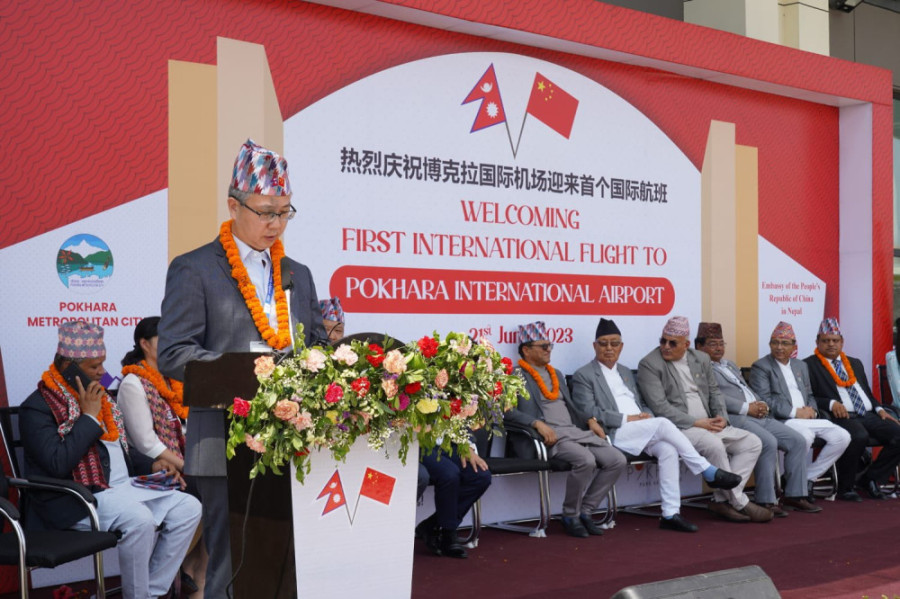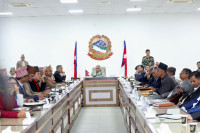National
China envoy again packs a geopolitical punch as new Pokhara airport suffers
Chinese officials say it is Nepal’s decision to have only nine projects under the BRI framework, not theirs.
Anil Giri & Sangam Prasain
On December 31 last year, on the eve of Pokhara International Airport inauguration by Prime Minister Pushpa Kamal Dahal, the Chinese Embassy wrote on its Twitter account that “This [Pokhara airport] is the flagship project of the China-Nepal BRI cooperation.”
Six months after the airport’s opening, a Sichuan Airlines charter flight landed in Pokhara on Wednesday with 84 passengers on board the Airbus A319 aircraft. They are here for the Nepal-China Friendship Dragon Boat Race Festival scheduled to be held in Pokhara on Friday.
Local tourism entrepreneurs have been celebrating the arrival of the international flight at the $215.96 million facility built with Chinese loan, but no one knows when the new airport will get regular international flights.
The operator, the Civil Aviation Authority of Nepal, is tightlipped about the new airport’s commercial prospects.
The airport has already been mired in geopolitics.
Adding a sucker punch, Chinese Ambassador Chen Song, on Wednesday, reiterated that Pokhara airport falls under the Belt and Road Initiative (BRI), a flagship multi-billion dollar infrastructure initiative undertaken by Chinese President Xi Jinping.
Nepali government officials, however, have been rejecting the Chinese claim that links the airport to the BRI as ‘unilateral’.
A senior official at the civil aviation body told the Post, “We cannot make any public statement as it is up to the government to clarify whether the project is under the BRI.”
“The statement made by the Chinese ambassador will definitely hurt the tourism prospects in Pokhara. The two international airports in Pokhara and Bhairahawa, one funded by China and another constructed by Chinese contractors, have worried the southern neighbour,” he added.
Nepal has been prodding India for air routes to connect these two multi-million dollar infrastructures but to no avail. Without the entry routes from India, neither project is financially or technically viable, insiders say.
On Wednesday, speaking at a function in Pokhara after the landing of a first charter flight from China, Ambassador Cheng said, “The Pokhara International Airport, which commenced in January, was planned and constructed with the assistance of the Chinese government. It was built by Chinese engineers.”
“Today, we have achieved a significant milestone with the successful landing of an international flight. This achievement falls within the framework of the Belt and Road Initiative project.”
But for Nepali officials, the new airport infrastructure has become an albatross.
“Obviously, such statements create trouble,” Ramesh Thapa, president of the Nepal Association of Tour and Travel Agents, said.
“If the Chinese can operate scheduled flights on an airport built under its flagship project then, to an extent, the business will grow. Otherwise, the project is in crisis.”
There are no official words from China for a commercial flight. For Chinese planes, coming from Tibet, the [Indian] routes won’t matter as they arrive from eastern Nepal. Nepal has a dedicated route for flights to and from Tibet, which pass through Tumlingtar and cross the border near Everest.
Some Chinese flights, particularly from Guangzhou, use the Simara route to enter and exit.
Lawmakers too are worried.
“This is an issue which should be raised in Parliament,” said lawmaker Rajendra Bajgain, who represents the Nepali Congress.
Bajgain, who is also a tourism entrepreneur, said the foreign ministry should seek clarification from the Chinese ambassador for making such a one-sided remark. “He has now said it twice. We don’t want to be a victim of geopolitical rivalry.”
The Civil Aviation Authority of Nepal and the Chinese EXIM Bank, the financier of the Pokhara airport project, have signed an agreement to pay back the loans solely through the income of Pokhara airport. There is a dedicated escrow account to pay the instalments.
Under the agreement, it is difficult for the government to repay the loan on the stipulated time because aviation experts say that Pokhara airport isn’t commercially viable until India allows additional air corridors.
Besides, the airport has payload issues.
A preliminary report shows that narrow-body jets like the Airbus A320 and A319 have payload issues due to obstacles near the airport, which is a 25-minute hop from Kathmandu.
Airports have load restrictions determined by obstacles, runway length, temperature, quality and other factors.
According to officials at the Civil Aviation Authority of Nepal and some pilots the Post talked to, the preliminary report has shown a payload penalty ranging from 5-10 tonnes, depending on the temperature and distance.
“If we cannot repay the loan, we will be forced to take more loans from China. There is pressure on Pokhara to earn and pay for itself,” said Bajgain. “But no one knows how.”
“The statement of the Chinese ambassador is definitely for geopolitical consumption. Who will suffer? Our tourism,” said Bajgain.
The government signed a $215.96 million soft loan agreement with China in March 2016 for the construction of the new airport in lake city.
The loan agreement between the Civil Aviation Authority of Nepal and China EXIM Bank does not mention the BRI.
In May 2014, two years before the loan was agreed, China CAMC Engineering was given the construction contract, at a time when the BRI was in a nascent stage.
Chinese President Xi first announced the idea of the BRI in 2013 as ‘One Belt, One Road’. China’s Exim Bank had agreed to provide 25 percent of the loan free of interest and set the interest rate at two percent an annum for the rest of the amount, with a payback period of 20 years.
After Nepal and China signed the framework agreement on BRI in 2017, Nepal initially selected 35 projects to be undertaken under Chinese President Xi Jinping’s flagship connectivity project. Later, at Beijing’s request, the total number of projects was whittled down to nine, with Pokhara airport off the list.
There are some controversies over the BRI. According to Chinese officials, Nepal has kept nine projects under the framework. But that is Nepal’s unilateral decision. For China, Nepal-China cooperation under the BRI is more loosely defined and it has a broader ambit.
“We do not know much about the geopolitical rivalry between China and India but it should not halt our business,” another senior official at the civil aviation body said. “These kinds of statements do great damage to our hopes.”
“Actually, we did not need an airport in Pokhara because we need to protect the pristine glory of Pokhara,” said Mahendra Poudel, a member of Skal International, a professional organisation of tourism leaders around the world, promoting global tourism and friendship.
“It’s built now and this chapter is closed. We now have no option to making it viable. But if we cannot conduct regular flights in Pokhara, it will be useless.”
Tourism entrepreneurs said that the two giant neighbours should not give trouble to Nepal.
“They should support us. If we cannot get regular flights and only chartered flights are commenced, that’s not going to help us. The multi-million project will be a white elephant,” said Thapa, a tourism entrepreneur.




 16.12°C Kathmandu
16.12°C Kathmandu





.jpg&w=200&height=120)










